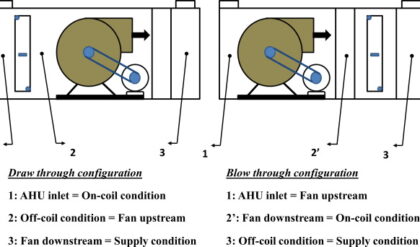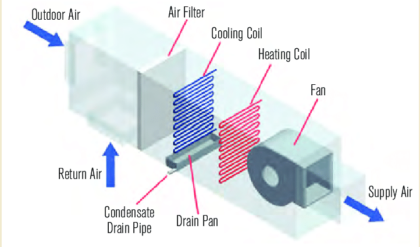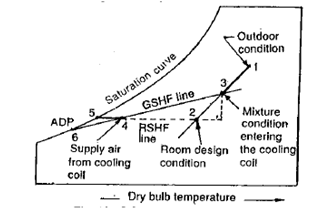Sensible Heat V/s Latent Heat
Sensible Heat is the heat content causing an increase in dry-bulb temperature.
Latent Heat is the heat content due to the presence of water vapor in the atmosphere. It is the heat which was required to evaporate the given amount of moisture.
Sensible Heat Factor
An air-conditioning process describes the change in thermodynamic properties of moist air between the initial and final stages of conditioning as well as the corresponding energy and mass transfers between the moist air and a medium, such as water, refrigerant, absorbent or adsorbent, or moist air itself. The energy balance and conservation of mass are the two principles used for the analysis and the calculation of the thermodynamic properties of the moist air.
The thermal properties of air can be separated into latent and sensible heat. The sensible heat ratio (SHR) of an air-conditioning process is defined as the ratio of the change in absolute value of sensible heat to the change in absolute value of total heat, both in Btu/hr:

SHF = sensible heat factor
SH = sensible heat
LH = latent heat
TH = total heat For any air-conditioning process, the sensible heat change
SH = 60 * Vs * ρ * c (T2 – T1) = 60 * m * c * (T2 – T1)
Where • Vs= volume flow rate of supply air, cfm
• ρs = density of supply air, lb/ft3
• T2, T1 = moist air temperature at final and initial states of an air-conditioning process, °F and
• The mass flow rate of supply air is m = Vs * ρ
The latent heat change is
LH = 60 * Vs * ρ * (w2 – w1) * hfg = 1060 * 60 * Vs * ρ * (w2 – w1)
Where w2, w1 = humidity ratio at final and initial states of an air-conditioning process, lb/lb. In Equation above, hfg ~ 1060 Btu/lb represents the latent heat of vaporization or condensation of water at an estimated temperature of 58°F, where vaporization or condensation occurs in an air-handling unit or packaged unit.
The ratio of space sensible cooling to total cooling is useful for plotting the slope of the path that supply air travels after introduction into the space. The relationships among the psychrometric states, capacities, and sensible heat ratio are shown graphically in figure below. For a given pair of entering and leaving air states, the figure shows that sensible, latent, and total capacities are proportional to the differences in temperature, humidity ratio, and enthalpy, respectively. The SHR is defined by the slope of the line connecting the two points.






Comments are closed.